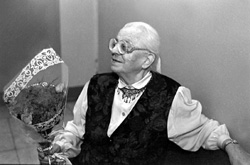Noted historian Olena Apanovych is 80

“Ukraine's last Cossack and a woman at that,” was the intelligentsia's bitter joke during the dark years of Soviet stagnation concerning noted historian Olena Apanovych. She was also referred to, quite justifiably, as the first woman to have penetrated Zaporizhzhia and stayed there for the rest of her life. She is eighty, meaning eight decades lived most actively and fruitfully. She feels extremely proud about being among the first in Ukraine and the only woman recipient of the Cross of the Ukrainian Cossacks.
The reason for such Cossack publicity is her widely acclaimed book, The Armed Forces of Ukraine of the Second Half of the Eighteenth Century. It took some courage to combine the notions of armed forces and Ukraine at a time of set ideological taboos, proclaiming to the world that Ukraine did have this significant attribute of statehood in the past. It made her name and simultaneously landed her in big trouble. To begin with, her book was arrested, all copies confiscated the public libraries, and the author was fired from the Ukrainian Academy of Sciences Institute of History, to be reinstated only in 1995, 24 years later. Needless to say, none of her articles appeared in print. Yet she wrote and her works were published in Moscow and Leningrad, so Ukrainians could use them to learn things that were severely suppressed by Malanchuk, then Ukraine's Party boss.
In that trying period, subject to countless restrictions, she would not even be allowed often to meet with people who admired her as a scholar and courageous public figure. One of them, a foreigner, would bitterly remark later that he was able to kiss her hand only a quarter of a century later.
Olena Apanovych thinks that she achieved success working side by side with Mykhailo Braichevsky, author of the expressly anti-Soviet article “Reunification or Annexation: Critical Remarks Apropos a Certain Concept,” and writer Ivan Senchenko's wife Olena Kompan, her colleague and dedicated alter ego. In the 1960s they made a legendary trio worth their successor best respect.
One can only marvel at this modest woman. Born to a Belarusian family in a Russian backwater, spending her childhood in Manchuria, raised mainly on Russian culture, she would become obsessed with the Ukrainian national idea and explore the terra incognita of the Zaporizhzhian Sich at a time when recognized names in history and scholarship were afraid even to approach them.
By right she could be referred to as the trailblazer in the history of Ukraine as a state formation. In 1994, she was conferred the Shevchenko Prize for outstanding merits in the scholarly field, specifically for a series of historical works, including the book Hetmans of Ukraine and Military Leaders of the Zaporizhzhian Sich . She is also laureate of the prestigious Antonovych Foundation Prize.
In fact, one small book she wrote, The Ukrainian-Russian Treaty of 1654. Myths and Realities (1944), is worth volumes of historical studies. It not only refutes Soviet historical falsifications, but offers the historical truth based on irrefutable documentary sources. Also, the works V. I. Vernadsky: His Life and Activities in Ukraine and
Art in the Life and Creative Work of V. I. Vernadsky were an extremely important landmark in her creative path. In them she elucidated the Ukrainian mentality of the man who actually created the Ukrainian Academy of Sciences of 1918 and was its first President, who was a leader of world natural history of the twentieth century, thinker, and descendant of the Zaporizhzhian Cossacks.
She is very good company, and one enjoys listening to her, whatever the subject. She is a person of extremely broad interests, yet Zaporizhzhian Sich is her pet subject. She can talk for hours on end and remains very active at her age. In fact, she seems tireless. She has just finished work on the Cossack Encyclopedia for Young People incorporating findings contained in her many books and articles (totaling 400) covering decades. The manuscript is ready. It is with the Veselka Publishers waiting for a sponsor. Her new study Chortomlyk Zaporizhzhian Sich: In Commemoration of Its 345th Anniversary appeared quite recently. It was shortly followed by the conceptual Our Lord at the Plow: Ukrainian Cossack Agriculture in the Context of Serhiy Podolynsky's and Volodymyr Vernadsky's Ideas . Among her just finished books is one of reminiscences about noted historian Fedir Shevchenko, and she is actively working on an article about the Cossacks for an encyclopedia of modern Ukraine. In fact, the article is evolving into a fundamental scholarly work synthesizing previous studies and latter-day Cossack history revived over the years of independence.
Producing scholarly ideas, synthesizing the results of previous Ukrainian historical studies, Olena Apanovych broaches new subjects, revealing new aspects of Ukraine's Cossack past. She is quite optimistic and one of her pet phrases is that work does not heal your ills but prevents you from sinking to the bottom of affliction.
Newspaper output №: Section






